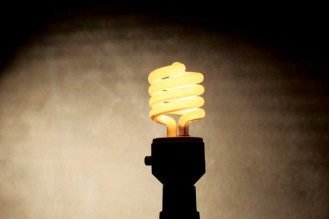Did you hear? Incandescent light bulbs are banned. Are Second Amendment rights next? Or even worse—will we all soon look like zombies in our bathroom mirrors?
Luckily the answer is “no” to all the above. But given the prevalence of conflicting information about the incandescent bulb phaseout, it’s worth shedding light on the issue.
The issue: those cheap light bulbs that you’re accustomed to using are disappearing.
Their disappearance is a signature element of George W. Bush’s Energy Independence and Security Act (EISA). EISA aims to reduce gasoline consumption to increase energy security, mitigate climate change and improve air quality and human health. Because only 5 percent of a traditional light bulb’s energy goes toward producing light and the rest is wasted as heat, bulbs that can’t improve their efficiency are being phased out. This means all “general-use” 40 to 100 watt incandescent bulbs. All major bulb manufacturers lobbied for this phaseout, likely because such bulbs aren’t very profitable.
EISA prohibits companies from importing or manufacturing inefficient “general-use” bulbs. Ownership or use of such bulbs isn’t banned. Nor is manufacture or import of “specialized” bulbs like those in your fridge, oven, chandelier or flood lights.
Are we alone in adopting these standards? Nope. Our policies mimic those of Europe, Russia and China. Yes, China. Planning to drive across the border to stock up on vintage incandescents? Sorry, but Mexico and Canada’s bulb policies go into place this year, too.

Incandescent
So what’s all the fuss? Mostly it’s that folks don’t like the government telling them what they can and can’t do.
Even some tree-hugging Boulderites feel like they’ve been backed into a corner, because early incandescent alternatives stunk. Replacement halogen, compact fluorescent (CFL) and light-emitting diode (LED) bulbs were plagued by high cost, ghostly pallor and Pac-Man flicker.

Compact Fluorescent
Today’s halogen bulbs, now repackaged as “eco-” or “high-efficiency” incandescents, are touted for their ability to produce similar light to traditional bulbs. But because they’re only slightly more energy-efficient than traditional incandescents, they too will go the way of the yellow pages when the final EISA efficiency provisions go into effect in 2020.

LED
CFLs have a reputation for being slow-starting cold-intolerant swirly bluish beasts. Early LEDs weren’t much better. But newer “soft-white” CFLs and LEDs are cheaper, last longer than earlier versions and emit light that’s indistinguishable from
incandescents. Despite the EPA concerns about CFL’s mercury content, there’s abundant epidemiological and environmental data indicating that fear-of-broken-CFL-mercury is overblown. And, rollout of CFLs and LEDs has actually reduced public health risks from mercury because they’ve
helped reduce electrical demand on power plants—whose widespread emission of airborne mercury comes from burning mercury-tainted coal.
So how do we navigate this bulb morass and make the most of our hard-won time and dollars? Consider the average Coloradan who shops for a top-rated “warm” or “soft”-white bulb at Home Depot. To replace a burned-out bulb used two hours per day in their living room lamp, a halogen ($2.75) will pay for itself in just over two years. But it may only last about
two and three-quarter years, making them about as cost-effective and energy-efficient as a hybrid Humvee, with light that is no better than the best two-buck CFL. That CFL will pay for itself in about seven months, yet last 13.5 years on average. The best-buy LED ($13) will pay for itself in about three and a half years and last 34 years. For bulbs used more regularly, like in your kitchen, hallway or porch—payback times and longevity are much shorter.
LEDs are a slam-dunk for outdoor fixtures or ones that are a pain to replace—such as our neighbor’s ceiling fixture that requires yoga-atop-a-ladder to change the bulbs. Because LEDs last 25ish times longer than traditional indoor bulbs, you’ll waste less of your valuable time changing them, and expose yourself to fewer falling risks. But if your pesky fixture is in a hot location, go with CFLs because LEDs perform poorly at high temperatures.
And aesthetics? Despite better light quality, increased longevity and plummeting costs, CFLs still have all the elegance of an ’80s cell-phone brick. Yet they’re inexpensive workhorses, so consider them for spaces where hue isn’t an issue or where quick dimming isn’t essential. Perhaps splurge on warm LEDs for your favorite spots like over the kitchen table and bathroom mirrors.
Or save some dough by waiting. Remove your still-working incandescents from all nonessential places in your house and save them to use in your favorite spots. Fill the vacancies with cheap CFLs so that by the time you’re out of incandescents, the next-generation LEDs will have arrived. They’ll be so cheap and dazzling that you’ll forget that lighting was ever an issue in the first place.
But if you want to hoard dinosaurs, better rush to your local big-box. Hurry—cheapo incandescents are going fast at only 50 cents a pop!
James W. Hagadorn, PhD, is a scientist at the Denver Museum of Nature & Science. Suggestions and comments are welcome at jwhagadorn@dmns.org



0 Comments